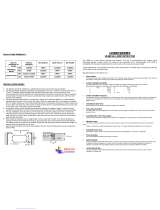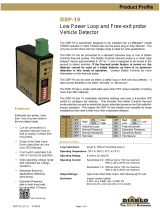Page is loading ...

Safety Instructions:
• All installation commissioning, repair, and service work to this product must be
undertaken by suitably qualied and trained personnel.
• The unit must be earthed.
• Disconnect the power before working on the unit.
• On 230 VAC models, a readily accessible disconnect protection device must be
incorporated in the mains wiring.
• On all models, the power supply MUST have short circuit protection and over
current protection installed at the power source. Typically, this will be a 5Amp
Magnetic Circuit Breaker for AC models and a fuse for DC models.
• This product must be installed in an enclosure.
• Always suspend trafc through the barrier area during installation and test as this
may result in unexpected operation of the barrier.
• There are no serviceable parts or internal settings inside the product. The product
warranty will be voided if the cover has been removed or if there is any tampering
with the product.
Electrical Connections:
• Refer to the side-label on the side of the unit to verify the corresponding pin-out
functions for both the 11 Pin Connector and DIN Rail housing variants of the LC20
the pin-outs may vary from model to model.
• Before connecting the detector to the power supply, ensure that you have the
correct power supply for the model you are using:
- LC20 - 2 - RB/DR 230VAC = 230VAC
- LC20 - 2 - RB/DR 12-24VAC/DC = 12V to 24V AC/DC
Front Panel Indications:
The front panel indicators consist of a Red Power / Communicator LED and two Green
Channel LEDs.
Description Function
Power LED
This red LED is on to indicate the unit is powered and functional
This red LED is also used as a communications interface with the LC20DT
diagnostic device to obtain information from the unit.
Channel
LEDs
These green LEDs indicated the current status of the two detector
channels. The can indicate four possible conditions namely, tuning, idle,
detect, or fault.
• Tuning condition - the detector is currently tuning the loop - green LED
ashes at a rate of 2Hz
• Idle condition - no vehicle is detected- green LED is off.
• Detect condition - a vehicle is detected passing over the loop - the
green LED is on.
• Fault condition- the detector is unable to tune to the loop as it is either
out of operational conditions such as low signal strength or frequency
out of range or there exists a fault on the loop such as a short circuit or
an open circuit - the green LED ashes at a rate of 2Hz.
If the fault is self-healing the detector will continue to operate but the green
LED will ash at a rate of 1Hz.
DIP Switch Selections:
Presence Time (Switch 10) – The presence time setting determines how the
detector will track a detect. There are two selection options available, namely
permanent presence and limited presence. The permanent presence mode setting
will maintain the presence of a vehicle over the loop by continuously compensating for
all environmental changes. The limited presence mode setting will limit the presence
of a vehicle over the loop and the presence time is related to the size of the detect.
Typically, a 1% ∆L/L will timeout after approximately 1 hour.
• Pulse or Presence on Detect (Switch 9 and 8) -When a vehicle enters the
loop the relays can either give a 150ms pulse on detect or maintain an output
for the duration the vehicle is detected. Each channel is set individually as per
the faceplate.
• Fail-safe of Fail-secure (Switch 7 and 6) – The relay outputs can be switched
between fail-safe and fail-secure. Each channel is set individually as per the
faceplate.
• AB Logic (Switch 5) - This is used to count cars in a specied direction. A
transition from loop 1 to loop 2 (forwards) results in a 150ms pulse output on
Relay 1. The opposite direction results in a 150ms pulse output on Relay 2.
• Automatic Sensitivity Boost (A.B.S.) (Switch 4) – ASB is a mode which
alters the undetect level of the detector. ASB causes the sensitivity level to
be boosted to a maximum on detection of a vehicle, irrespective of the current
sensitivity level maintained at this level during the entire presence of the
vehicle over the loop. When the vehicle leaves the loop and the detection is
lost, the sensitivity level reverts to the pre-selected level. This is typically used
for vehicles with high beds, or vehicles towing trailers, where it is important to
maintain the detect over the entire length of the vehicle.
• Automatic Frequency Selection (A.F.S.) (Switch 3) - This setting allows
the detector to briey evaluate all ve frequency bands and select the best
operating frequency available. The tuning time with AFS switched on can
range between 5 and 20 seconds. With AFS switched off, the frequency can be
selected manually.
• Manual Frequency Selection (Switches 1 & 2) - **AFS must be turned to
the OFF position to select the frequency manually. There are four possible
frequency selection options, High, Medium-High, Medium-Low and Low.
• Sensitivity (Switches 1 to 4) – The sensitivity of the detector determines the
change of inductance necessary to produce a detect. There are four possible
sensitivity selection options, High (0.01% ∆L/L), Medium-High (0.02% ∆L/L),
Medium-Low (0.05% ∆L/L), and Low (0.1% ∆L/L). Sensitivity can be set per
channel as indicated by the faceplate.
Relay Outputs:
The LC20-2 has one relay output per channel. Both are congurable as either
presence or pulse relays and may be set to Fail-safe or Fail-secure mode. The relay
states for the two fail modes are shown in the table below:
Presence Relay Programming
Fail Secure Fail Safe
Relay
Undetect Closed Open
Detect Open Closed
Fault Closed Closed
Power Off Closed Closed
Pushbutton:
The pushbutton is a multipurpose button which can be used to initiate a retune or can
be used to either enable or disable the power fail feature, depending on how long the
pushbutton is held in.
Description Hold Function
Reset 3 sec This will initiate a detector retune.
Power Fail 10 sec
Hold for 10s to determine the state of Powerfail. If the
LEDs are ON, Powerfail is ON. If the LEDs are OFF,
Powerfail is OFF
Power Fail Toggle 30 sec
Holding for 30s will determine the Powerfail status. The
state of the Powerfail is known after holding for 10s. After
30s, if the LEDs turn OFF, Powerfail is now OFF. If after
30s the LEDs turn on, Powerfail is now ON
Automatic Frequency Selection:
The Automatic Frequency Selection (A.F.S) feature enables the unit to briey evaluate
all ve frequency bands and select the best operating frequency available. It weighs
up each selection based on where the frequency is located within the operational
range, the signal strength, and the level of detected noise. AFS allows the detector to
evaluate all the frequency selections.
Due to the increased processing required, AFS takes longer to tune than when it
is deactivated. The tune time with AFS on can range from 5 to 20 seconds. If after
this period of time, the detector still has not tuned, it is also possible that none of
the frequency selections are suitable for the loop. If this occurs, manual frequency
selection should be used. Due to the sporadic nature of noise, the channel may seem
quiet during the evaluation but still suffer from cross-talk.
Power Fail:
The Power fail feature allows the unit to remember its operating conditions and
detect status in the event of power being removed. When power is restored, the unit
continues operating from saved conditions and status. This is designed specically for
fail safe situations to retain the output state and prevent a glitch on the outputs for a
power failure. As such, when the power is restored the detector will not retune but will
instead return to the detect state prior to the power failure. If a vehicle was on the loop
during the power failure, it will remain detected when the power is restored. Thus, it
prevents the tuning out of a vehicle over the loop during a power failure.
Loop Installation Guide:
Optimum functioning of the detector is largely dependent on factors associated with
the inductive sensor loop it is connected to. These factors include choice of material,
loop conguration and correct installation practice. A successful inductive loop vehicle
detection system can be achieved with the following constraints in mind and strictly
following the installation instructions. The detector must be installed in a convenient
weatherproof location as close as possible to the loop.
POWER
CH1
CH2
RESET
307FP0202-00
LC20 - 2 INSTALLATION GUIDE
TDOCT-6306_ENG
***Note: This is representative of the LC20-2 default wiring. Units may have
varied relay wiring therefore it is advisable to verify the expected relay outputs
with the side-label of the unit.

1. The loop and loop feeder cable should be constructed from an XLPE (Cross-
linked polyethylene) insulated multi-stranded copper conductor with a minimum
cross sectional area of 1.5mm².
2. The feeder cable should be twisted at a minimum rate of at least 20 turns per
meter.
3. The perimeter of the loop must not exceed 30 meters.
4. The area of the loop must not exceed 30m² and must not be less than 1m².
5. The recommended number of turns is typically based on the loop perimeter - refer
to the table below.
6. Sensing loops should, unless site conditions prohibit, be rectangular in shape and
should normally be installed with the longest sides at right angles to the direction
of trafc movement. These sides should ideally be 1 meter apart.
7. When two adjacent loops are laid in close proximity to each other, it is good prac-
tice at time of installation that a different number of turns are used in each loop to
prevent cross-talk.
8. Joints in the loop or feeder are not recommended. Where this is not possible,
joints are to be soldered and terminated in a waterproof junction box. This is ex-
tremely important for reliable detector performance. Other forms of joins such as
those available in kits, where the joint is properly sealed against moisture, are also
permitted.
9. All permanent loop installations should be installed in the roadway by cutting slots
with a missionary cutting disc or similar device. A 45° crosscut should be made
across the loop corners to reduce the chance of damage that can be caused to
the loop at right angle corners. The slot should have a nominal width of 4mm and
slot depth of between 30mm and 50mm.
A slot must also be cut from the loop perimeter at one corner of the loop to the roadway
edge to accommodate the feeder. After the turns of wire are wound into the slot around
the loop perimeter, the wire must be routed again via the feeder slot to the roadway
edge. The loops must then be sealed using a “quick-set” black epoxy compound or hot
bitumen mastic that blends with the roadway surface.
Loop Perimeter No. of Turns
3-6 meters 4 Turns
6-10 meters 3 Turns
10-30 meters 2 Turns
Fault Caused by Remedy
Red LED
does not glow
on power up
If the Red LED
indicator is off, then
there is a fault with the
power or the power
connection unit.
Check the power feed to the unit.
Check the power connections to the unit.
After the initial
tune period
the CH Green
LED remains
ashing at
2Hz
The unit cannot tune
to the loop due to
either a faulty loop or
feeder connection.
The loop inductance is
too small (<20µH) or
is short circuited.
The loop inductance is
too large (>1500µH) is
open circuit.
AFS is ON and one
of the channels
is unused or
experiencing one of
the above problems.
Faulty Detector unit.
Check the loop installation and the loop
connections. Check the on-board diagnostics
using the LC20DT to conrm the fault.
Check that there is no short circuit on the loop or
feeder wiring. Re-install loops if required.
If there is no short circuit on the loop, verify the
loop inductance using an LCR meter. The loop
inductance should lie between 20µH to 1500µH.
Add loop turns to increase loop inductance.
Check if there is electrical continuity of the loop
and feeder. Check all loop connections are
secure. Re-install if required.
If the loop is not open circuit, verify the loop
inductance using and LCR meter. The loop
inductance should lie between 20µH to 1500µH.
Remove loop turns to decrease loop inductance.
Turn the AFS DIP switch OFF and hold the
reset button for 3 seconds to invoke a retune to
determine which loop is faulty.
Replace unit.
After tuning,
the loop
output LED
ashes
intermittently
and the relay
chatters.
The loop is getting
spurious detections
due to:
a. Crosstalk with the
loop of an adjacent
detector.
b. Faulty loop or
feeder connections
a. Change the frequency setting of the detector.
b. Check the loop wiring and ensure that the
feeders are adequately twisted. Ensure that
any joins in the loop feeder are soldered and
made waterproof.
Fault Caused by Remedy
c. Electrical Noise
d. Movement of the
loop in the ground
e. The sensitivity of
the detector may
be set too high.
c. Check that the loop feeder cables are
adequately twisted. Ensure that the loop
feeder cables are run separated from any other
electrical cables to reduce any electrical noise
coupling. Use screened loop feeder cable
and ensure that the screen is earthed at the
detector only.
d. Check the loop installation for cracks in the
road near the loops, as well as the condition of
the loop sealant.
e. Set the sensitivity lower on the DIP switches
Changing
Frequency
DIP switches
does not
initiate a
retune.
The A.F.S feature
is enabled, which
overrides the
manual setting of the
frequency.
The A.F.S DIP switch needs to be switched off in
order to congure the frequency manually.
If A.F.S is disabled, holding the reset button for 3
seconds will result in the detector retuning.
The detector
remains in
detect after
the vehicle
has left the
loop.
a. The sensitivity of
the detector may
be set too high.
b. The loop is noisy
and A.S.B feature
is enabled.
c. Movement of the
loop in the ground
or the feeder
cables.
d. Poorly crimped
terminals
a. Determine the required sensitivity level via the
on-board diagnostics using the LC20DT. Set
the sensitivity lower on the DIP switches.
b. Switch A.S.B feature off on the DIP switch
c. Check the loop installation for cracks in the
road near the loops, as well as the condition of
the loop sealant. Ensure the feeder cables are
secure in the cabinet/enclosure.
d. Check the loop connection to the terminals.
***IMPORTANT NOTE***
On INITIAL installation:
• Automatic Frequency Select (AFS) is disabled by default. On power-up the
detector will attempt to tune to the frequency determined by the Frequency DIP
switches. Should the AFS DIP switch functionality be required please enable it
using the AFS DIP switch and hold the reset button for 3 seconds to invoke the
retune.
• Should only ONE inductive loop be connected to a dual channel detector, AFS
MUST BE DISABLED or a dummy loop should be connected to the unused
channel to achieve successful tuning.
• Power Fail functionality is disabled by default. Should the Power Fail functionality
be required it may be turned on using the reset button. Press and hold the reset
button for 30 seconds to toggle the power fail functionality. After holding the
reset button for 10 seconds the LEDs on the unit will indicate the state of the
Power Fail functionality. If the LEDs are OFF power fail is OFF and will turn on
after 30 seconds. If the LEDs are ON, power fail is ON and will be turned OFF after
30 seconds.
3 turns of
loop cable
Loop sealant
Road Surface
4mm
30 - 50mm
300mm 300mm
Dependent on Road
45° CROSSCUT TO PROVIDE STRESS RELIEF
1m
CURB / ROAD EDGE
TRAFFIC DIRECTION
SAW CUTS
World Headquarters
Pepperl+Fuchs GmbH
Lilienthalstraße 200
D-68307 Mannheim, Germany
Email: F[email protected]
USA Headquarters
Pepperl+Fuchs-Inc. Twinsburg.USA
Email: F[email protected]
Asia Pacic Headquarters
Pepperl+Fuchs Pte Ltd. Singapore 139942
Email: F[email protected]
307LF0202_00
TDOCT-6306_ENG
January
2019
Fault Finding Diagnostics:
/



![Eberle DesignDeflectometer Inductive Loop Monitor [LMD602, LMD602T, LMD604,LMD604T]](http://vs1.manuzoid.com/store/data/001476625_2-352a61b560d4fc181793a55d495056b5-160x210.png)
